
Nepal
26,759 feet 8156 meters
|
 |
Manaslu
2013 Summit Report Nepal 26,759 feet 8156 meters |
|||||||
|
||||||||
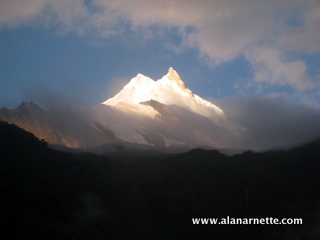 As
I made the final turn to Manaslu's Base Camp, the mountain came into view.
It was huge. A large massif with smooth snow slopes, glacier remnants,
huge snow blocks and a pinnacle that defined mountain tops. I stopped in
my tracks as a moment of doubt crept into my mind. But soon a smile of
anticipation overwhelmed me as my pace increased the final few steps to
the Altitude Junkies expansive Base Camp site. As
I made the final turn to Manaslu's Base Camp, the mountain came into view.
It was huge. A large massif with smooth snow slopes, glacier remnants,
huge snow blocks and a pinnacle that defined mountain tops. I stopped in
my tracks as a moment of doubt crept into my mind. But soon a smile of
anticipation overwhelmed me as my pace increased the final few steps to
the Altitude Junkies expansive Base Camp site.
Manaslu is the worldâs 8th highest mountain at 26,759â or 8,156 meters. It is not as popular as many of the other 8000 meter mountains and is known as a death trap. 67 people have died and only 672 had stood on the summit. An avalanche in 2012 killed 11 climbers in their sleep at Camp 3. I was soon to sleep in the same area. This trip report goes into details on my climb and is most useful for those interested in climbing Manaslu, armchair climbers or those who want to visit the inner thoughts of an amateur climber, myself. For those who want the quick version, visit the Frequently Asked Questions page on my site. Also, please visit the picture gallery to see more images. Make sure you use the slideshow feature. ExpectationsDuring a 2012 interview with the Canadian Broadcasting Company, I sounded off arrogantly. âA climber is someone who climbs an 8000m mountain before and after Everest. A Peak-Bagger is someone who only climbs Everest then stops climbing.â My big mouth! I had climbed several 8000m mountains before summiting Everest in 2011 but had only climbed smaller peaks since then. So as I was looking at climbing plans, I felt the pressure to put my feet where my mouth was (easy to do for me!). As I looked at the 8000m mountains, Pakistan felt off-limits for a variety of reasons but Manaslu kept emerging as a potential expedition. My good friend Phil Crampton had run Manaslu expeditions since 2008 and knew the mountain as well as anyone. His Altitude Junkies Sherpas had fixed the route and reached the true summit on every climb. Phil leads his expeditions, not guides. This means he establishes a first rate base camp, also the high camps with tents, stoves and fuel. But his clients do all the rest - carry all the personal gear (sleeping bags, pads, clothes, food) - adding up to 20 or more pounds, a lot at 7000m, cook their own food, melt snow for water and make their own climbing decisions. Phil also has an outstanding working relationship with Russell Brice of Himalayan Experience or Himex. This year, 2013, Himex had the big team of 2 Guides, 15 members and 12 Sherpas. As the largest team, they would be fixing the route to the summit. The 2012 avalanche had sent many teams back to Cho Oyu for their Autumn 8000m expedition but still there were about 12 teams from all around the world at Base Camp representing about 150 Westerners and 100 Sherpas. A busy place. The BeginningOur journey began on August 27, 2013 with a few days in Kathmandu as
the small team of six arrived from the UK, South Africa, Australia, Belgium
and the US. It was a diversity of cultures, experiences and thoughts
- some six sigma away - just how I liked it. The dinner conversation
promised to be interesting. The highlight before we left was the required meeting with Ms. Elizabeth Hawley. Ms. Hawley is the record keeper for Himalayan summits. As I covered in a Blog post, she drilled us on the specifics of our climb and promised to follow up upon our return. If she said we summited, it was fact. But taking advantage of the opportunity, I chatted casually with this legend about the future of climbing, the changing Sherpa culture, the ânewâ 8000m mountains recently designated, plus the fight on Everest this past Spring. She was honest, unedited, informed and a delight. She felt a lot of the recent controversy was simply boys behaving badly. She said it was total nonsense. She was optimistic about the future of climbing but unsure who would take the lead. She held the Sherpas in high respect as she did the pioneers of Himalayan climbing. She had a wistful look in her eyes as she talked about Sir Edmund Hillary and the impact he had in the Khumbu. I left Kathmandu with a sense of history and purpose. The TrekMany teams, including Himex, take a helicopter from Kathmandu to the
remote village of Sama Goan at the base of Manaslu. The flight takes
36 minutes. The trek takes six days. It is one of the most beautiful
treks in Nepal along with the Khumbu and the Annapurna Circuit, but that
is when it is not raining! For us, we started with a bone jarring drive over deep mud rutted roads to the village of Arughat at 1,870â or 570 meters. This altitude is significant because it would mean we would virtually walk from sea level to the summit of an 8000m mountain, something few people ever accomplish. Our trek took on Groundhog Day characteristics. Rising at dawn for a cooked breakfast, walk a few hours, break for a cooked lunch, walk a few hours, camp that night. Each day was miserably hot. Sweat formed from the first moment of movement and got worse. The only respite was the low clouds that blocked the sun, and the view. But the view that was there was; it was simply magnificent. For all the complaining we did about the heat, humidity and constant moisture; words could not capture the beauty of the waterfalls, the rain forest, the villages, the power of a river that I had never witnessed as it transitioned from a silt-laden muddy color to the clear turquoise associated with glacial runoff. My progress was constantly interrupted by stopping to just stare. I had never seen such a powerful demonstration of nature anywhere in the world. Tramping the Milford Track in New Zealand offered stunning waterfalls, trekking the Baltoro Glacier offered amazing mountain views, driving the roads of Patagonia followed raging rivers. But nothing put them all together like the Manaslu Trek. To see it with clear skies in November or December would be a treat. The trek was like a trip backwards in time starting with somewhat modern day Nepal with all the normal trappings of cell phone service and tea houses with showers. But soon the culture became simpler, the Tibetan influence stronger as the homes were built of stone, cut from local quarries. The timber was hand sewn from the local forest. Everything made by hand. Nothing mechanized. A building boom was underway preparing for the onslaught of tourist as the Manaslu Circuit was gaining in popularity. I was glad to see when I did. Base CampAfter a few days acclimatizing in Sama Goan, we hiked the final stretch
to Manaslu Base Camp. The extremely steep trail followed a glacier still
in its glory but obviously smaller than in the past. The moraine emptied
into a turquoise lake with small ice blocks creating a tiny flotilla.
The forest soon thinned as we broached treeline revealing the towering
Himalaya surrounding our home away from home for the next month. Base Camp was like many other Himalayan Base Camps, multi-color tents dotted the landscape. Ours had two large domes, one for dining and the other for communications. Phil provided four laptop computers and four Bgan satellite modems for Internet connections - no waiting! We each had our own SIM that allowed us to check email, phone home and for me, post dispatches. But all this depended on power. Several large solar panel sat quietly outside the tents waiting for the sunlight each day. But the low clouds of the trek followed us up valley creating a mist that drained the batteries. Phil insisted on not using a generator - not green - so often we played the charging game thus limiting our access. All in all, not a bad thing. Da Passang Sherpa, our head cook, was a magician. I know many climbers say their Sherpa, guide or cook is the best anywhere and there are many excellent ones working for the operators. I cannot understand the current trend of bringing in foreign chiefs on these Himalayan expeditions. All I can say is that I have never eaten so well in over 30 major expeditions. The meals were a delicate balance of protein, carbs and fat. His use of spices were a treat to the senses and care for the results obvious. Phil would use the helicopter flights designed for other reason to ship in fresh meat or vegetables. For the first time, I did not loose weight on a Himalayan expedition. Finally, we had fully dedicated tents for the toilette and hot shower.
Toilettes with seats. I know this sounds luxurious but it makes a huge
difference when you spend days on end at Base Camp in damp, cloudy conditions.
The little things Phil did made the entire experience enjoyable. However it was his daily âHappy Hourâ that made it unique and special. Everyday at 4:00 PM, Phil would âdemandâ our presence in the dining tent. Orders were taken for red or white wine or juice. Trays with diced cheese, bowls of olives and chips were presented and the conversation would begin in earnest. Soon visitors from other teams would miraculously appear just wanting to say hello but stayed until dinner time. It became a great way of breaking the monotony, making new friends and getting to know one another. The conversation was never disappointing. One of the regular visitors was HImexâs Russell Brice. He would relax with us and tell his many tales of climbing, and leading expeditions. I learned a lot about this man and what makes him tick. At his deepest, he is a climber with first ascents on Everest, speed climbs on Cho Oyu and many other unknown feats. He is actually a bit shy and modest all hidden behind a gruff exterior that makes up his deep knowledge of mountaineering, running an expedition and how to get clients safely to the top of mountains and back home.Climbing!A Lama from Sama Goan hiked up to Base Camp to perform our Puja. It
was longer than usual at the request of the Altitude Junkies Sherpas
who were still concerned after last yearâs avalanche. The ceremony concluded
in a downpour of rain with Sherpas holding an umbrella over the Lama's
head. After a few days adjusting in Base Camp, we set off to tag Camp 1 on September 11, 2013. This was not a difficult task but required carrying a sleeping bag, some food and perhaps the down suit from 15,750â/4800m to 18,700â/5700. This is about the same altitude as Everest Base Camp on the South side. The route started on a dirt trail over some rock slabs then across running water to the edge of the glacier aptly named Crampon Point. Here we put on our crampons and harness to begin glacier walking to the Camp. It was simple but required attention to detail as there were many crevasses. Phil said the snow level was at a much higher level than in previous years thus exposing more crevasses. The Sherpas had a fixed line established about half way to C1 that most people ignored and did not clip into. The first climb took about 3 hours with half that for the return. A good introduction to Manaslu but grossly understated what was to come.
Camp 2 - The Crux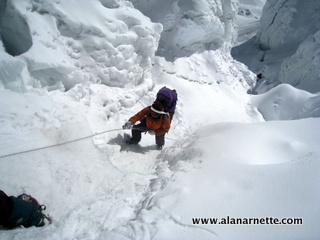
We spent a few days letting our bodies generate red blood cells as a result of the carry to Camp 1. More happy hours and relaxing times in spite of the continuous rain each day. But when the sun did shine the views were amazing. We would stand outside the tents or borrow Russellâs spotting scope to investigate the route. Specifically we were curious about the results of the 2012 avalanche. Russell noted it had taken the snow down to the rocks thus, in theory, removing another potential avalanche from the mix this year. But large snow cornices and seracs dotted the mountain side and nearby, avalanches fell continuously creating a regular roar that turned heads all day and night. Manaslu was not asleep. The next rotation was to spend a night at Camp 1 and another at Camp 2. I wanted to spend two nights at C2 based on my Everest experience. I felt that the more time I spent at high altitude, within reason, the better my body reacted and prepared for the summit push. With that as the plan, several of my teammates joined me. The trip to C1 was uneventful with many of us cutting the climb time due to improved acclimatization. Our packs were full with more personal gear plus food for 3 to 4 nights on the mountain.
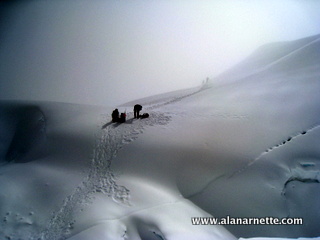
On September 14 we left for Camp 2 as the sun rose gently touching Camp 1. The large party from Himex was camped next to us and got a head start but with so many people, it was easy to pass them and soon I was on my own separated from other climbers including my own teammates. Climbing with Altitude Junkies is different than with other services. The only time you have a Sherpa with you is on the summit push, otherwise you are free to do what you want. I liked this freedom and soon got into my own rhythm as I made steady progress through 7000 meters. The Himex Sherpas had worked hard to put a fixed line on the route but it was still uncertain. There had been little traffic so there were almost no steps kicked into the steep sections. And steep they were. The section between Camp 1 and 2 was noted as the âtechnical cruxâ with a short section of steep climbing known as the Hourglass which was then followed by switchbacks on ramps to reach Camp 2. 2013 was different. The snowfall had been low in the summer thus exposing the glacier, crevasses and creating several sections of difficult climbing.
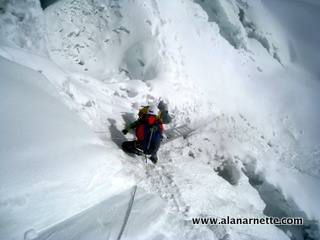
Himex had three ladders and another hidden away. All four were used from the start whereas usually only one was used all season. The Sherpas spoke quietly that Manaslu was different this year. I soon found myself using my jumar, a mechanical device that prevented you from falling when attached to a fixed line, to ascend the steep sections. The front points of my crampons got a full work out. I cursed the weight of my pack as it pulled on me during the rough sections. Just as I reached the top of a snow gully, I thought I would see Camp 2; but was disappointed. It was an endless series of steep climbs followed by a short ramp then another climb. I lost count as I pushed on. In the midst of this, I paused to look around. I was alone, surrounded by house sized ice blocks, ice cycles glistened in the bright sun. A faint boot track outlined the thin nylon safety rope. It was silent. I hitched my pack higher on my hips as I confidently placed the 12 points of my crampons into the soft snow. My gait was slow, steady and secure as I moved higher. I took a deep breath. I was climbing.
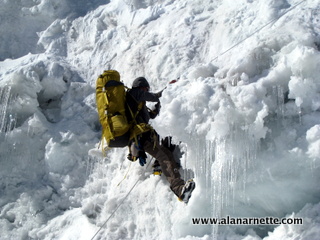
At one point, a few Sherpas passed me, not unusual on the big mountains. I stepped aside and watched them navigate one of the narrow, steep gullies. They attached their jumar, leaned back on the fixed rope and pulled with their arms all while balancing a 60 pound pack filled with supplies. They used a herringbone technique with their footwork placing their crampons at 45 degree angles while placing all the points into the snow to gain the maximum purchase. The last few ramps below Camp 2 were tortuous. They were steep. With the sharp demanding gully climbs now behind me, I spotted a single tent knowing this was not our camp but curious if someone had run out of steam or thought this was a good spot to establish Camp. There are no rules, climbers can do what they want. Finally, I saw a long row of tents. Hmm, that must be Himex. Yes. Ours was on a ridge slightly above. Four Mountain Hardwear tents in a straight line. Phil was standing nearby waving at me. I pulled into Camp, happy to be there. It had taken 5 hours. Not bad for an old man.
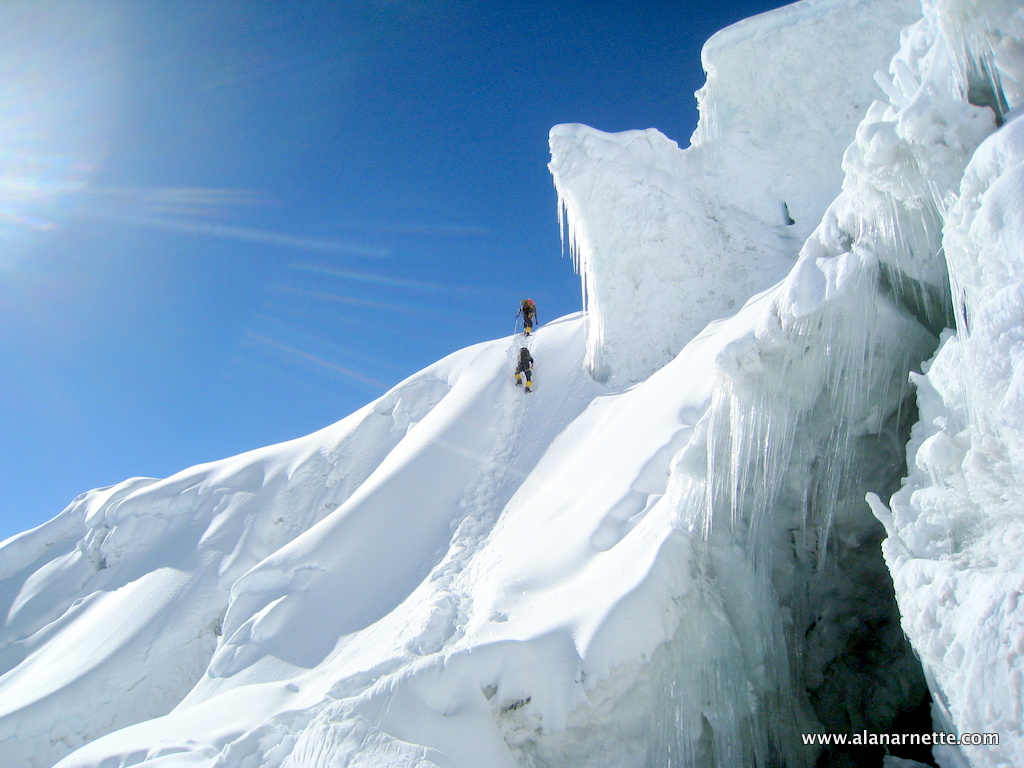
I took my pack off and began melting water. I was down a few liters to be sure. As I looked around, the next level of Manaslu was revealed. I could see where the avalanche took place last year, the crevasse that still held one of the fallen. I was high on the mountain as the afternoon sun was flirting with the mountain skyline. It felt good.
Watching the WeatherWe spent two fitful nights at Camp 2 passing the time adding and subtracting clothes as the temps cycled between the extremes. Camp 2 on Manaslu is roughly equal to Camp 2 at the base of the Lhotse Face on Everest. The down climb to Base Camp was uneventful with the huge exception of the multiple, technical rappelling to Camp 1. The route had changed again and the Sherpas had repaired broken ladders to ensure continuity. More teams were now making their way to the higher camps so the route was a bit more busy but still manageable. We had now completed our acclimatization process and were ready to go for the summit.Back at Base Camp, we all settled in to wait for the next weather forecast and the promise of a window suitable for our summit push. The next day brought a big rain storm at base camp. We wondered what was happening up high. 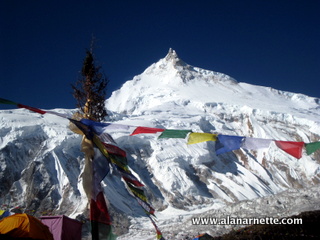
Soon the answer came: a foot a Camp 1 and two at Camp 2. Bad news. The French team had made a hasty retreat back to BC and other teams has stopped their plans. The mountain needed time to let the new snow settle. The last thing we wanted was another avalanche. Knowing the ropes would be covered, or tents collapsed, Phil sent his Sherpas back up to break the trail to Camp 3 in a couple of days. It was hard work but they reached the objective thus reopening the trail for everyone else. The Himex Sherpas followed fixing the route to Camp 4 and establishing the High Camp to be used on the summit push. Oddly, no Sherpas from any of the other teams participated in the route or rope fixing in spite of being asked and offered the same bonus as the Altitude Junkies and Himex Sherpas. Phil used a service from US based Michael Fagin, a long time mainstay in Himalayan weather service while Russell used the Swiss based Meteoexploration. Other expeditions used their favorites and some sponged off the paid services wandering by to start some smalltalk which inevitably lead to questions about the weather forecast. Poor form. The next few days passed with little difference - bright morning sun followed by clouds, rain and sometimes snow in the afternoon. Happy hour was a relief each day as was Paulâs laptop which provided us with the first two seasons of Game of Thrones. On Thursday, September 20, Phil delivered the news. âThe latest from Fagin says no window for a while.â Spirits sank deeply over breakfast. We all new the risk of an extended stay at BC but the overall weather had been pretty good to this point and talk was abundant of an early summit. Phil kept talking about the 2009 climb when they summited on September 25, the earliest ever for his team. Now it looked like we may slip into October, a more normal summit date. We returned to our tents, each in our own unique state of funk. I went to the gear tent and began packing. I had seen this before. On Everest we went through the identical process only to be told the forecast changed and at 10PM one night we prepared to leave for the summit push in four hours. Sure enough, history was about to repeat itself. That same afternoon, Russell came over with his MacBook Air. He showed us the forecast from Meteoexploration. It showed a narrow window of good weather with a good summit day on September 25. A quick email to Fagin in the middle of his night confirmed the window. Game on! Summit PushTo go to the summit of a big mountain like Manaslu, it takes several days. We prepared to make an orderly push spending a night at each camp: 1, 2, 3 and 4 with our summit bid starting early on September 25. The weather looked bad starting on the 26 so we knew we had to get off the top as quickly as possible and return to one of the lower camps that same day if not Base Camp itself. If we missed this window, the next one might not emerge for a couple of weeks, if at all.
On September 21, we gathered for a late lunch before one by one heading up to Camp 1. Our packs were not large since we had carried most of our gear already to either Camp 1 or 2 but still, we new this time it was for real. The large Himex team left the same day so the trail was busy. Other teams were still doing acclimatization rotations, some had just arrived from Sama Goan but a few drafted on the good weather forecast and followed along. We arrived at Camp 1 around sunset, hydrated and ate dinner before going to bed. On September 22, we headed to Camp 2 and another climb of the challenging seracs, slopes and gullies. Once again the route had changed especially after the new snow but now we were familiar with the route and challenges. I arrived at Camp 2 in about the same time as before. I saw no need to push myself and got into my âsummit attitudeâ by conserving my strength. I enjoyed the climb, the views and took it all in. One mistake I had made in previous climbs was to be so consumed by the task that I forgot the big picture. Today I stopped and looked around, took pictures and simply let it all sink in. 
I crawled into my tent at C2 and began the endless job of melting snow for water. My tent mate, PK, and the rest of the team plus our Sherpas all soon arrived and we ate dinner and fell asleep. The next day was a very short climb to Camp 3. I made it quickly, about 2 hours, beating the rest of the team and our Sherpas, who in fairness, were moving the tents from Camp 2. I once again enjoyed sitting quietly on my pack viewing an amazing expanse of Himalayan peaks. In a rare moment of quiet, I thought of home, what was important and why I was here. While at Camp 3, a bit of drama unfolded when one of our teammates, Dan, began feeling strange. HIs tent mate Damien noted that Dan's speech was slurred. Phil, making a command decision, ordered him down immediately fearing AMS or worse. Dan and Dorge Sherpa made a quick retreat to Camp 1 on supplemental oxygen where Dan began to feel better. While disappointed, Dan later reported it was the correct decision. Now at Camp 3, 6800 meters, the real work was about to begin. The Himex team began using supplemental oxygen at 2 lpm at this point but we were not scheduled to start the Os until Camp 4 at 7400 meters. Paul and I got a head start on the other climbers leaving Camp 3 around 7:00AM. We set a steady pace but with the new snow, it took some work to break the trail. Paul took the full workload early on but was soon passed by two Sherpas. I got into my rhythm and was pleased with my progress. The route proved surprising. From Camp 3, it appeared to be a long snow slope but the angle was deceiving. It was an ever-increasing slope starting flat, moving to 20 then 40 degrees. In the middle it went steeper requiring the jumar once again before becoming a steady traverse to the High Camp at 7400 meters. It was a very, very tiring climb. I took five hours but others took twice that time or more. Pulling into Camp 4, I was tired but deep down felt satisfied that my intensive training back in Colorado the previous 6 months was paying off. I was now at 24,500' or 7450m about the same altitude the Yellow Band on Everest between Camp 3 and the South Col. I had climbed here without supplemental oxygen. I felt no impact from my knee surgery in January. Overall, I was pleased with how my body, and mind, was reacting to this high altitude challenge. Summit NightNow at C4, sitting on my pack beside Phil and Paul, I looked up at the route to Manasluâs summit. From Camp 4, the true summit remained elusive as it had throughout the entire expedition. It was only back in Sama Goan that we saw it, but the spiky East Pinnacle dominated the view otherwise. I knew by now that the slopes of Manaslu were misleading. Phil simply pointed up and said it was that way. 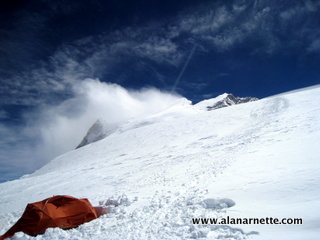
My previous research showed the route from C4 to the summit was on a "plateau". In my mind that meant flat, similar to Cho Oyu. But there was nothing flat about what I was seeing. It was a series of long slopes that perhaps flattened out at times but overall looked to be a sustained climb of over 750 meters or about 2,500 feet - a long way at this altitude. I crawled into my tent and began making preparations for our 3:00AM start. It was about noon. I dozed as I heard other climbers come into Camp 4 throughout the afternoon. This is where I made a mistake. Instead of melting snow, I was lulled by the altitude to whisk away the afternoon. Finally around 5, I brewed a pot for myself and PK but should have pounded at least two liters that afternoon. PK soon arrived, knackered. He had pulled a 10 hour day. Another teammate Damien was still on the trail then arrived after 12 hours. Spending that much time at this altitude is difficult. They never gave up but spent a lot of energy reaching the high camp. I was proud of my teamates. We started up the oxygen bottles sleeping on 0.5 lpm throughout the
short night. I crawled into my sleeping bag with all my base layers and
down suit plus boot liners on ready to go as soon as I woke up.
A firemanâs start. I began to notice the positive impact of oxygen as
I tried to sleep. I would turn it off but sleep was spotty, I would
sit up struggling for breath before lying back down to fall into a soft
slumber but not a real sleep. I had plenty of Oâs but for an unexplained
reason was reluctant to use it. Finally, I succumbed, setting my regulator to 0.5, the small amount of precious gas allowed me to fall into a deep sleep for a few hours. PK, meanwhile was going through a similar ordeal. Arriving later than me, he continued to melt snow for water and dinner. But like me, he had no appetite and passed on the nutrition - a mistake on both our parts. At 2:00 AM I heard rousing in the nearby tents. At first I thought it was more sleep-talking as one of the Sherpas in nearby tent was chanting prayers throughout the night. I was not sure if this was a good or bad sign just before the summit push! But waking up quickly, I put on my boots and packed the rest of my meager gear into my pack. I topped off my water bottle but failed to eat anything. Leaving the tent, I measured the air temp at 9F, not bad really. I was warm in my down suit. Knowing that bowels can be an issue on 8000m summit pushes, I stealthily found a rock to hide behind and did my duty. It was an ordeal fiddling with the layers and multiple zippers but I was glad I took the time. Looking around, Camp 4 was coming to life with climbers leaving tents, chatting softly in the bright glow of multiple headlamps. There was no wind on this clear night. Thank you Michael Fagin. I placed my oxygen bottle in my pack surrounded by a couple of emergency layers, extra down mittens, goggles and one liter of water in a bottle parka to prevent it from freezing. My pack felt light. I felt strong as I put on my harness and crampons. I was ready to climb. The Summit ClimbThe large Himex team got the jump on everyone else. I glanced around
for Pasang Ongcho, my Sherpa for the summit night and saw him talking
to Phil. It was the first time I was waiting on a Sherpa! But that was
only for a moment. He came over and checked my oxygen setting - 2 lpm.
Soon, I fell in line behind the 27 year-old. He is one of the few UIGMA
certified Sherpas in Nepal. Incredibly skilled and strong, I was comforted
to know he had my back this night. As is usual on these large peaks, the weather window dictates when people attempt the summit. As a result many climbers often go at the same time. Tonight, September 25 was the first attempt of the autumn 2013 season. Phil and Russell had agreed to combine teams for this first push and in fact Phil and Passang Nima Sherpa were carrying rope and gear to assist the Himex Sherpas, Phurba Tashi and Ngawang Tenjing, in finishing the fixed rope to the summit. The early climbing was tedious. The slopes, as expected were loaded with snow. As the angle increased, the Sherpas put in the thin nylon safety line. This required burying snow pickets every 100 meters and takes time. Soon the line of climbers ground to a halt as the work ensued. I knew from previous reports the summit push should take anywhere from 6 to 8 hours one way but with the forecast of incoming weather, I also knew there was no time to waste. The Sherpas competed their work quickly and efficiently and the line began to make steady progress. Pasang was efficient to move us around stopped or slow climbers thus soon we were nearing the head of this high altitude snake. I continued to feel good but was getting thirsty and hungry. This was the first time I had actually felt hungry on a big mountain summit push. I guess it was good, but the feeling was unusual but there was no time to stop. We made steady progress towards 8000 meters. In the dark, the route appeared as an endless series of groomed snow slopes. But I knew better. We were on one of the worldâs highest mountains, in remote Nepal where a mistake could cost a life. While there was security in having others around, climbing these peaks was a solo affair. Encapsulated within a down cocoon, hearing my own breathing, seeing the tips of my red boots contrasted against the white snow, every sense was simultaneously heightened and dulled. It was a world unlike any other on the planet at that moment. 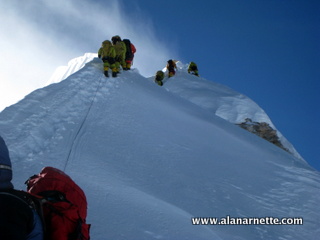
During a pause in the movement, I looked behind me. The sun was rising. I remembered this on Everest and had the same overwhelming feeling of comfort and warmth. The dark night was giving way to the day. I watched for a moment as the sun seemed to be in fast motion, the rays lighting up the tops of the Himalaya as a search light would from a helicopter. The mountains were no longer dark and mysterious but now warm and welcome. I wanted to take a picture but I needed to keep moving. The wind picked up. A tinge of cold crossed my chest as a layer of sweat betrayed my base layers and down suit. I shook myself like a big dog and clapped my hands as if I was at a football game. I felt better The sunlight brought a new sight to my limited vision - a peak. Is was not the summit, the notoriously difficult and elusive true summit - but rather one of the three false summits that have tricked mountaineers for decades on the 8th highest peak on earth. But I knew we were close. It must have been around 6:00AM with the sunrise. I looked back at my red boots on the white snow and took another step. I noticed a crowd ahead. The Himex gang. They were stopped at one of the only flatfish spots thus far switching out oxygen bottles. They were running at 4 lpm and had two bottles per climbers. Pasang and I paused to take in the view. Then I witnessed an amazing moment in high altitude mountaineering. Phurba Tashi was leading the line when it was as if he said, âEnough, we going to the top.â With superhuman strength he separated from the pack, breaking through the knee deep snow at 8000 meters. 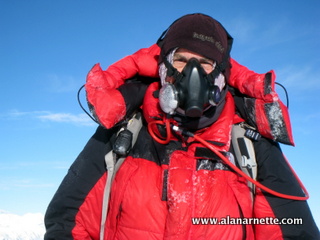
Within a few minutes he was on his way, rope around his neck and under his arm to fix the route to the summit of Manaslu. Pasang and I reached the flat spot and swapped out my oxygen bottle. I took out my water bottle for a welcome drink and shared my Honey Stinger chews and gel with him. At least my empty stomach now had something to do. Knowing my cached oxygen bottle was still half full, I had a nice reserve if we had to wait for the summit. We pressed on. The route took a few turns as we approached the summit. It was strange to see such a circuitous route near a mountain top, but Manasluâs summit was complicated. Finally, we climbed a narrow snow ramp that turned a corner to see the goal. Pasang seemed to have slowed down and now I understood. A line of down clad climbers stood quietly on a two foot wide boot path staring higher as Phurbu Tashi bravely plowed one step at a time towards the true summit. In the early years of Manaslu summits, the top was bare rock, but in recent decades it was mostly snow covered but a bit of bare rock was exposed this year. Proud, and confident Phurba placed an anchor for the fixed line into some of the exposed rock, attached the rope and soon stood on the top paving the way for the rest to follow. I counted the climbers ahead of me, 32 in all. One by one or two by two they made the final treacherous climb to the top. I noticed the climbers made small movements, careful steps; the summit was small, a mistake costly. With Himex guide, Bruce Hasler directing traffic for his team, they hugged, unfurled banners, laughed, smiled and recorded the moment. Over the radio, they thanked their Big Boss, Russell Brice. He simply said âWell done, now get down.â to each of them. Phil Crampton and Passang Nima were amongst the first to summit then passing Pasang and myself on the way down. A simple down covered fist bump was the order of the day. Scary Summit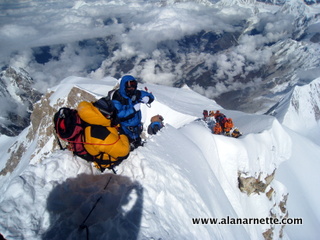
I looked up at the final climb noting how narrow it was. Earlier I had glanced to my left to inspect the cornice. The winds had created a thin snow wall, a cornice, along the summit. It was deceiving as one false step would easily collapse the wall sending the climber to their death, free falling thousands of feet toward Samo Goan. No hyperbole, this was as real as it gets. The safety line was there but would it hold a grown manâs free fall? I planted my crampons securely as I took a step forward. The final route took on more importance as I reached the last slope to the true summi*t. The climb was short, maybe 20 feet but steep, about 50 degrees. I took my ice axe out to add another point of contact. I made sure I was clipped in my with metal carabineer. I kicked a step into the snow, the soft snow drifted around my boot. I gave it another go, and another. It only took a couple of minutes but felt longer. When I looked up and could no longer see snow in front of my face but only blue sky, I knew I was there. The final steps took what remained of my breath away as I struggled to stand upright like a gymnast struggling with an awkward dismount. 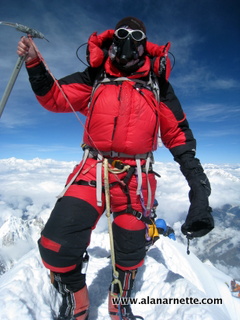
As I gained my balance, I looked around. There was no higher spot. I was standing on the summit of Manaslu, 26,759â or 8,156 meters, the worldâs 8th highest mountain. It didnât sink in. I looked to my left, a drop-off of thousands. I looked to my right, an equal drop-off. Ahead, the summit ridge went lower along the pillow soft snow cornice. Behind, ten more climbers stood quietly below, staring at me, willing me to get going. I took out my camera and pointed it towards Pasang. The veteran took off his goggles, smiled and posed like Mr. Universe for his all important summit photo. I handed the camera to him. We both held the camera together for a second to ensure a positive transfer. I held my ice ax out in a triumphant sign but the leash stopped me short. Pasang took the photos. I paused as I took the camera back. Looking around, I saw what I had come for, the tops of other mountains. But in the same moment, I began to breath again. I felt relief, satisfaction, and fear. I know the tired saying about the summit being half way but a summit is a summit. 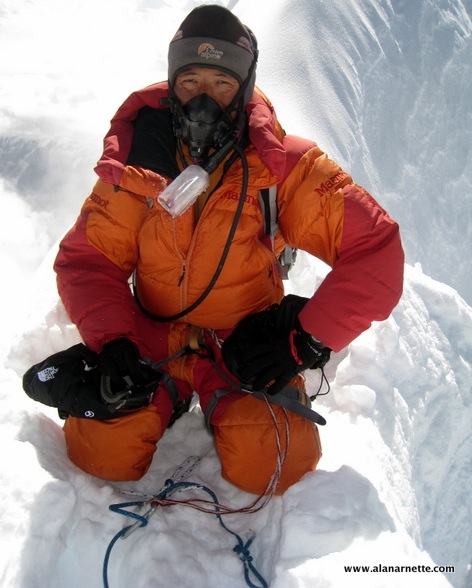
This was my summit. I was standing on the summit. Getting here was hard work. It was the result of setting a hard goal, working hard to reach it. It was the culmination of loving support back home, unquestioning allocation of what was needed to make it happen. I was here alone but also with so many in my heart. As I glanced at the impatient line below me, I allowed myself to let it sink in, to send my thoughts into the air to the ones I love, to say thank you. As I took a step back down, my right foot brushed the cornice and it drifted away. I recoiled instantly establishing a death grip on the fixed line. I would not make that mistake again. I stumbled my way back down, knowing I had 200 meters of similar terrain before I reached the relative safety of an open snow slope. Later I would realize I was panting heavily, my cardio system running at full tilt. Paul and Louis quickly followed me to the summit along with their Sherpas Chhongba and Tarkey. I was very proud of our entire team. LowerThe down climb to the lower camps illustrated my previous mistake of not hydrating. I knew better but had let the seduction of altitude lull me into resting and not taking care of myself. From Camps 4 to 3 to 2 to 1, I struggled, craving a cold drink of water. Arriving at each camp, the Sherpas were supportive but fuel was low or pressure was on to break camp before the impending storm. Once at Camp 1, I found a stove and pot and began the long process of melting snow to rehydrate. Once in my sleeping bag, I fell into a deep sleep for the next several hours. The next morning, we returned to Base Camp only to learn that Phil had a near miss with death. On his descent, he was carrying four empty oxygen bottles in addition to his normal load. His weight collapsed a snow bridge sending him 50 feet into a crevasse. He was only holding onto the fixed line at the time but his grip saved his life. Other climbers passing by found him half an hour later and after setting up a z-pulley, pulled him to safety. It was a near miss. The end of these expeditions always come quickly, we left BC the next morning and took a helicopter from Sama Goan to Kathmandu that same afternoon saving a week long trek back out. Two days later I was on a plane back to the US. Memories are EverythingBeing able to climb where and what I do is a gift. The opportunity to see so many awe inspiring places, meet amazing people and spend more than a moment in unique lands are the rewards. I climb to discover, learn and test - and in those regards, I never fail. I know I am fortunate. I am grateful and try not to take it for granted. Life is precious. Memories are the key. Taking risks make the strongest memories. And it can all be taken away in a flash. 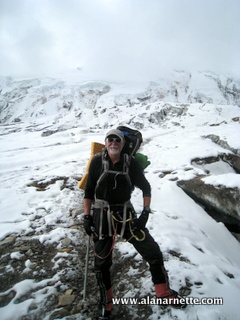
Each climb since the early 2000's are to honor my mom, Ida, and those with Alzheimer's. I do not benefit financially from this effort but do it to raise awareness and funds for non-profits. High on the mountains, the joy I feel is balanced by the desire to stop this disease. I climb mountains. Honestly, Iâm not sure how many more I can do. It takes time, money, determination and more. I hope to climb mountain of all sizes for as long as I can. I love the feeling but recognize the costs. If Manaslu was my last big peak, what a way to end! Standing on a summit, spending time with new friends, feeling the cold thin air against my skin, the sound of crampons on hard snow at 8000 meters; this is what it is. It touches something deep inside, something simple, something primal; something real. It also brings into focus a connection of the past, present and future. My mind drifts to memories sometimes lost. I deeply considers what I have today and what tomorrow might bring. Each expedition seems to bring a crossroad in my life. I rarely look ahead. I savor the moment, consider the current reality before moving forward. I am thankful for a safe return from Manaslu. I am grateful for the support during the climb. Tomorrow brings another day. Dream it, live it, share it. Climb On! Update October 2021: With new information that most people stopped a bit short of the true summit, this is my response when asked if I summited in 2013: "I thought I did. I was told by world-record Everest Summiteer, Phurba Tashi Sherpa, that I did. He fixed the ropes that year. But I saw a couple of snow bumps behind me and always wondered. Anyway, it really doesn't;t matter to me if I touched the precise tippy-top or not. I climbed with a great team, made wonderful lifelong friends and was encouraged during that climb to attempt K2, which I then summited (true!) the next year on my 58th birthday. So I call Manaslu a success." Expedition Video
|
|